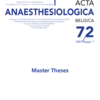Predicting perioperative acute kidney injury in liver surgery
Acute Kidney Injury; decision tree models; liver surgery; prediction model
Published online: Apr 21 2022
Abstract
Introduction: During the perioperative period, acute kidney injury (AKI) is a serious complication with increased short- and long-term mortality (1, 2, 3). In former studies, the incidence of AKI following hepatobiliary surgery varied between 5.1 and 15.5% (10, 11, 13-15). The aim of the study is to examine the perioperative risk factors for development of AKI in patients undergoing liver surgery and to compare predictive models made by supervised decision tree models.
Methods: In this retrospective cohort study, patients who had undergone liver surgery between March 2010 and December 2017 in Ghent University Hospital were screened after ethical committee approval. A set of preoperative and postoperative laboratory results, surgery and patient characteristics were collected. To create a predictive model, the dataset was randomly divided into a training set (60%) to train the model and a test set (40%) to analyze the accuracy of the model. To train the model, tree-based models were used in the form of a simple tree, pruned tree, bagging trees, random forests and boosting trees.
Results: 1162 patients were analyzed and because of missing data, 602 patients had to be excluded from the dataset. The misclassification error of the different decision tree models varied between 3.12% and 4.02%. Random forests is the prediction model with the lowest misclassification error of 3.12%. The difference in serum creatinine immediately after surgery is ranked as the highest predictor with a relative influence of 50% in the boosting trees model. This predictor is followed by postoperative serum creatinine with a relative influence of 13%. At the third place is preoperative hemoglobin with a relative influence of 9.2%.
Conclusion: Decision tree models can predict AKI after hepatobiliary surgery in this study. Of all the predictive models, random forests had the lowest misclassification rate and this model should be explored more often in future research trials.
